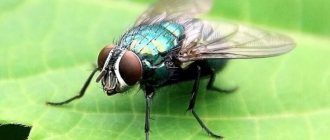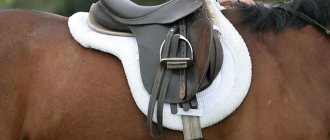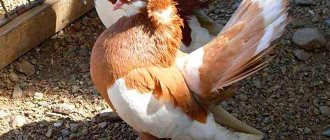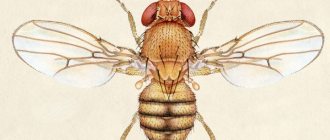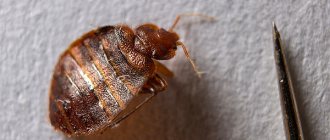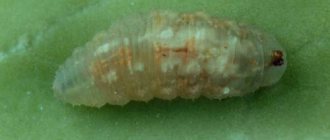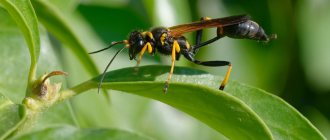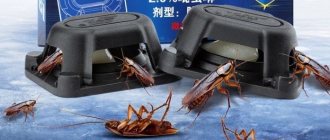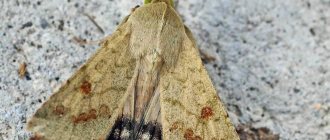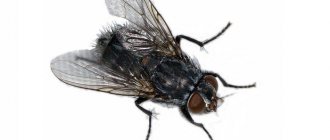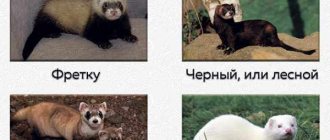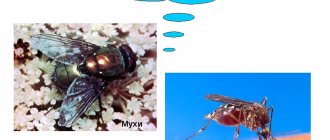Sergey Lysenkov
"Quantik" No. 6, 2014
We are all accustomed to the fact that an insect in a bright black and yellow outfit is a wasp and we should stay away from it. But take a closer look. This insect hovered in the air, then sharply jerked to the side and sat down on a flower. Come closer and take a closer look. Instead of powerful wasp mandibles, you will see a proboscis with a pad at the end - the same as that of a common housefly. And the whole head - eyes, antennae - of the insect are made of a fly, not a wasp. No longer afraid of being stung, pay attention to the wings - there are not four of them, as wasps should be, but only two. This means that we have met an unusual fly that imitates a poisonous wasp.
Most likely, this fly belongs to the hoverfly family. This is a very remarkable group of insects that are worth talking about in more detail. Their names in different languages reflect their different characteristics. The Russian name “hoverflies” comes from the sound they make in flight. In English, German and Dutch they are called “flying flies” because of their habit of hovering in the air; in Swedish, in Finnish - “flower flies” (sometimes they are called that in Russian); Czechs call them “pestryankas” (and also “osonki”), and Slovaks call them “quivering” (apparently also for their characteristic hovering in the air). The scientific name of this family is syrphids, which comes from the Greek word “syrphos” (“animal, mosquito”).
It is quite easy to distinguish hoverflies from those they imitate - you just need to practice and understand that not only bees and wasps can have a fluffy or striped body. The most obvious sign is the number of wings: like all flies, hoverflies have only one pair, while other insects have two. Actually, this is why the order of insects to which flies belong was called “diptera”. Although this sign is unmistakable, it must be admitted that it is not the most convenient: in flight, and even at rest, it is not always easy to see how many wings an insect has. It is much better to take a closer look at the head: the typical fly’s very large eyes, the characteristic proboscis, and often small antennae will clearly show that we have not encountered a wasp or a bee. If you often observe insects, you will most likely eventually be able to distinguish hoverflies by their general “fly-like” appearance and small flight characteristics that are difficult to describe in words.
Where can you find hoverflies? It is best to look for them on a sunny day near abundantly flowering plants - for example, in a meadow. Adults spend their lives there. They feed on nectar and pollen on flowers, where they look for a mate, and some lay eggs. Pollen, unlike nectar, which is a syrup of sugars, is a “heavy” food, and only a few insects are able to feed on it. However, it is also more nutritious, as it contains a lot of proteins. And female dipterans need the latter so that they can develop eggs: mosquitoes and horseflies drink blood for this, but hoverflies and some other flies have found a “vegetarian” way to solve the problem. But, unlike the above-mentioned bloodsuckers, the males of hoverflies also consume protein food.
Like most flower-feeding animals, hoverflies are pollinators. Usually, when people talk about pollination, they think of butterflies or bees. Of course, bees are the most important pollinators, but hoverflies should be placed in second place. Many of them have long proboscis, allowing them to penetrate deep flowers - although they, like other flies, mainly feed on simple, open flowers with easily accessible nectar and pollen.
Externally, hoverflies are very diverse. There are up to 6,000 species of them in the world, and 800 of them live in Russia. Many of them have a black and yellow (less often, black and white) coloring of spots and stripes, reminiscent of the coloring of wasps. Wasp flies masterfully imitate these stinging insects - some of them are similar not only in color and body shape, but also stretch their front legs forward, as if they were long wasp whiskers, and also bend their abdomen, as if they are trying to sting. Other flies - bee flies - imitate bees with a brown, furry body. It is believed that they also need hairs so that pollen sticks to them, which the beekeepers then clean off their bodies with their feet and eat. But bumblebee flies also imitate bumblebees in order to lay eggs in their nests. The very numerous sirphs, which give the name to the whole family, are small flies with yellow spots on an elegant thin abdomen. Some hoverflies do not disguise themselves as anyone, such as small chylosia with a black shiny body. Several species of hoverflies have large hind legs with swollen hips, unusual for flies.
If adult hoverflies are very different in appearance, but all feed on flowers with nectar and pollen, then their larvae are extremely diverse in their lifestyle. Some of them live in water, including in heavily polluted reservoirs. The most famous of them, perhaps, are the bee larvae - called “rats” for their long breathing tube, reminiscent of a rat’s tail. The larvae of sirphs and many related species are predators, feeding on aphids, caterpillars and other small herbivorous insects. They help in the fight against these pests. And the larvae of other syrphid species (for example, chylosia), on the contrary, themselves harm plants, parasitizing in stems and bulbs. There are also hoverfly larvae that feed on decaying organic matter (rotting wood, manure), parasitizing in the nests of social insects (such as the bumblebee flies mentioned above)... And this is not the end of the list! Perhaps few other families of flies have such a variety of possible lifestyles for their larvae.
Why do many hoverflies look like wasps and bees? The answer is obvious: to scare away predators. However, not all so simple. It is traditionally believed that in the case of mimicry - the so-called imitation of non-dangerous animals by dangerous ones - there should be fewer imitators than “originals”, because otherwise the predator will more often encounter non-poisonous prey and will not be able to develop the habit of not eating the owner of the characteristic color. But hoverflies are much more common than wasps. What's the matter? Entomologist Gennady Dlussky showed that coloration protects mimic hoverflies only during the period when chicks emerge. Adult birds, with an accurate and quick throw, will be able to grab any fly (and a hoverfly too). But the chicks starting to hunt are not yet so dexterous and slow down near the flower - all the flies get scared and fly away, and the bees and wasps, knowing that they can stand up for themselves, continue to feed calmly. Naturally, in this case the chick will be stung by some striped insect, although there were relatively few such dangerous insects. Subsequently, having matured and gained experience, the birds will learn to distinguish wasp and bee flies from wasps and bees - and will eat them with pleasure. But during the period of mass flight of chicks, the resemblance to stinging insects saves many hoverflies.
Photo by the author and Yulia Sycheva
Artist Yustas-07
What is the name of a small slender striped fly - very similar to a wasp
This insect can be found very often. A small fly with a striped body is able to quickly flap its wings while hovering in the air.
Many people get scared, mistaking it for a wasp, and are afraid of being stung, but the wasp does not have such ease of flight.
In fact, this insect is absolutely harmless, since it has neither a sting nor poisonous glands. What is the name of the small slender striped fly that looks very similar to a wasp? We need to figure it out.
Danger and harm of bee fly larvae
Eristalis tenax, or milkweeds, are the larvae of the bee fly that live at the bottom of small and dirty ponds and lakes, puddles, and farm wastewater. To breathe, they float to the surface of the water and put out a long tube, which reaches up to 27 cm and is capable of decreasing and increasing. Because of their resemblance to the tail, beekeeper larvae are called rats.
The adult that hatches from the larva is the eristalia fly. It flies out in the autumn season and feeds on flower nectar.
In appearance and color it resembles a bee. The bee fly larva has an undeveloped head and no eyes. The underdeveloped mouth is covered with a fold. There are no legs, but growths are visible at the bottom of the body. The rat has 7 pairs of false legs: 6 on the abdomen and 1 on the chest. Thanks to them, the fly crawls. A two-centimeter cylinder with a long tube at the end, which allows it to live in polluted or oxygen-free waters.
When it’s time for pupation, the bee crawls out to the coast. It transforms into a pupa inside the larval skin.
A couple of centuries ago there was an opinion that bees were born from carrion. The reason for the myth was a rat that can live in rotten liquid and turn into a wasp fly.
Note! The rat signals water pollution. If rats appear in a pond, it is better to avoid swimming in dirty water.
The entry of bee larvae into the human body gives rise to accidental intestinal myiasis. Infection occurs when eggs of the pathogen are swallowed with food or eggs are laid by a fly in the anus, from where the larvae make their way into the rectum.
Bee fly larvae
Symptoms, diagnosis, therapy
Maturation of larvae in the intestines leads to the development of enteritis.
Its manifestations:
- abdominal pain and diarrhea;
- nausea and anal itching;
- insomnia and dizziness;
- lethargy.
Sometimes the disease is asymptomatic.
The disease is diagnosed through laboratory tests of stool. Treat with laxatives, metronidazole, nifuroxazide.
Eristalis tenax larvae can cause genitourinary myiasis or vulvar myiasis.
Pathology is registered in:
- Africa and India;
- Argentina and Iran;
- Australia and Chile;
- Brazil and European countries (Spain, Belgium, Denmark).
Hoverflies, or syrphids, can easily be confused with their stinging counterparts: a bee or a wasp. They are an important component of the biosphere. Flies clear the planet of plant debris and are unsafe for humans.
This insect can be found very often. A small fly with a striped body is able to quickly flap its wings while hovering in the air.
Features of a slender wasp-like fly
When asked what the small, unusually slender striped fly is called, every biologist will answer: it is a hoverfly.
It belongs to the Diptera family of the short-whiskered suborder, which is very extensive - more than 6,000 species.
Most often you can find:
Among these species there are those that are useful to humans, and there are also garden pests.
Appearance
The slender striped fly, called the hoverfly, looks like a wasp only at first glance.
Upon closer examination, there are many differences:
Why are these insects so similar? If for a wasp such a bright color is a warning about its danger, then the hoverfly is camouflaged in this way.
Not having such a formidable defense in the form of poison as a predator similar to it, it repeats its coloring for self-defense, escaping from enemies.
This phenomenon is called mimicry.
With its help, a striped fly, similar to a wasp, pretends to be it. In flight, the insect's wings make a special murmuring sound, for which it received the name hoverfly.
There are a huge number of species of syrphids - and this is another answer to the question of what the striped fly is called. They differ greatly from each other depending on their habitat.
Entomologists even have such a specialization - syrphidologist. Among the entire vast world of insects, they chose this unusually slender striped fly to study.
Life cycle and reproduction
The first adult flies appear in late spring, and mating occurs at the end of July. To lay eggs, the female chooses a place where the larvae will have plenty of food.
The further cycle of metamorphosis is as follows:
During the development of the larva of some species of striped fly, up to 2000 insect pests become its prey.
Habitats and food
The striped hoverfly has colonized almost the entire territory of the earth's land. It's only too cold for her in Antarctica.
The habitats are very diverse and depend on the type of insect and the type of food that the larvae prefer.
Among the representatives of this family there are those whose larvae are herbivorous, and there are also predators among them. But this only applies to larvae.
All adults feed on pollen and nectar. The most preferred plants for them are complexly colored and umbrella plants, fruit bushes and trees.
Harm and benefits of the hoverfly
Most hoverflies are undoubtedly useful to humans. They not only pollinate plants in the absence of bees, their larvae free the garden and vegetable garden from pests.
Description of development
Adult hover flies lay white or pink microscopic eggs that take 8 to 12 days to develop. One female usually lays up to 200 eggs. The larvae, up to 10 mm in size, look very similar to a leech and move quickly.
The transparent, wrinkled body may be greenish, pink or yellow, with thin skin through which internal organs are visible.
Some larvae feed on aphids. Moving through the plants, they find and suck it out. It can destroy about 200 pieces per day. Other species live in muddy water, rotten wood, anthills, wasp nests, and manure.
Development in the larval stage lasts about one month. They then move into the next stage, the pupa. Hover flies overwinter as larvae or pupae.
The pupae resemble a drop of frozen resin with a dense shell (puparium) of brown or yellow color. After two weeks, a young individual emerges from them, capable of flying within a few hours.
Appearance
If you look at a photo of a hoverfly, you can see how impressive it looks. Thanks to multiple magnification, the use of modern technologies and equipment, everyone has the opportunity to carefully examine it. There are several varieties of hoverflies. Depending on this, its body looks massive or slender, the length ranges from 4 to 25 mm (it is believed that this is a huge fly).
The main feature by which it can be distinguished from other types of flies is the absence of hard hairs on the body, which is covered with fine fluff. The fly, similar to a bee, is dark in color with reddish or yellowish stripes located on the abdomen and back. In appearance it resembles a wasp, bumblebee or bee. But she has only one pair of wings, unlike these insects.
Hoverflies behave differently from ordinary flies. They fly differently and collect the wrong pollen.
Mimicry allows insects to escape from birds, which, deceived by their color, are afraid to attack.
The fly, similar to a wasp, has a special wing structure, thanks to which it is able to abruptly change the direction of flight or hover in the air and even mate.
Varieties of hoverflies
On the territory of Russia you can find the following types of these insects:
- Temnostoma vespiforme. This wasp fly has a characteristic striped color and a length reaching 18 mm. The larvae choose deciduous wood as food.
- An aquatic species of hoverflies. The eristalia fly obtains food in muddy bottoms and puddles with an unpleasant musty odor. A distinctive feature is the presence of a “tail”, which is a special breathing tube that allows you to breathe under water.
- In appearance, the insects are similar to a hornet. Characteristic features are a yellow striped convex abdomen; there are brown shading on the front of the wings. The body of adults is 13-18 mm.
- Delia antique. The color is dirty gray, body size is 0.7 mm. The larvae are pests because they eat garlic and onions and eat up rhizomes, causing them to rot.
- Eristalis tenax. The syrphid fly is very similar to a bee. The length of the body covered with down reaches 15 mm. Features: dark color, yellow narrow stripes on the abdomen. Can often be called a bee-eater.
Reproduction
An adult can lay about 200 eggs. They are small and white. The quantity depends on weather conditions and air temperature. The striped fly places them in plant stems, grass, and tree buds. After 7-10 days, larvae emerge from them, resembling the maggots of an ordinary blowfly in appearance. They feed for a month. After which they pupate. At the end of July and until September, flies fly out of them and lay eggs again. New larvae hide for the winter as soon as it starts to get colder. From these, new hoverflies with yellow bellies emerge at the end of June.
This type of fly can feed on aphids, plant stems and bulbs, small insects, dead plant tissue, processing wood and manure.
The food for adult flies is pollen, which is a source of protein necessary for the maturation of eggs and nectar, thanks to the sugar it contains, the flies are replenished with energy.
Hoverfly larvae are the worst enemies of spider mites and small insects. They eat both adults and their eggs. Watching them hunt for aphids is quite interesting. Crawling along the stem, the larva suddenly (at the sight of an aphid) stops and, like a snake, raises the front part of its body, swings and rushes at the victim. During the day, she is capable of eating hundreds of aphids.
How does it reproduce
The summer of flies begins at the end of May, beginning of June. The mating season of hoverflies usually occurs in July. One female lays up to two hundred eggs. She can place them in the grass, on plant stems, tree branches and on the soil surface (the place of oviposition usually depends on the type of insect). Thus, the onion hoverfly, which lives mainly on onions, lays eggs on the feathers of the crop.
The eggs usually take 8-12 days to develop. The legless, sedentary larvae that emerge from them resemble a flexible leech of a green, pale yellow or pinkish hue. The internal organs are visible through the thin skin. The length of the syrphid at this stage of development is about one centimeter.
The type of feeding the larvae may differ in is:
- predators use aphids, fleas and other small insects as food, helping gardeners fight small pests;
- herbivorous species damage lily bulbs and plant stems;
- larvae living in a reservoir use detritus as food;
- The dung and wood of dead trees provide food sources for exotic hoverflies.
Hoverfly larvae
In this way, the larvae feed and grow for 2-3 weeks, after which they move to the next stage of their development - the pupal stage.
The hoverfly pupa has a teardrop-shaped body. Pupae that remain over the winter are usually brown in color; summer pupae are light in color. After 10-14 days, an adult individual emerges from the puparia, which after 1-2 hours becomes capable of flight. With the onset of cold weather, the new generation of caterpillars hides for the winter.
Features, benefits, harm
The yellow-striped fly often eats nectar and pollen from plants. Therefore, it can often be found in places where shrubs and flowers grow. Since the larvae eat garden pests, fruit trees are preserved, which means there is a benefit from them. Hoverflies pollinate flowering crops, resulting in increased yields. But they eat garlic, onions, and damage the bulbs of many flowers: tulips, daffodils, hyacinths. Thus, they are pests, causing significant damage to lily crops.
Piedwings
This is a family of spotted wing flies. Most of them are small, only a few mm in length. Some species can reach 2 cm. They are harmless to humans, but cause serious damage to crops. The list of variegated flies includes the Mediterranean fruit fly with a red belly, which is exotic for Russians. Due to its size (up to 5 mm) and similar coloration, the details of which are difficult to distinguish without a microscope, this fly can easily be confused with Drosophila. The Mediterranean fly is not among the Russian pests, but can be imported along with citrus fruits - the main food for its larvae.
Fighting methods
Summer residents and owners of personal plots are interested in how to get rid of pests in order to preserve their harvest. Gardeners and gardeners recommend using several methods - chemical and folk remedies. In many ways, control methods depend on the number of pests.
Chemicals
An insect similar to a fly - the hoverfly - dies from the use of such means:
Any product should be used strictly following the instructions, otherwise you can not only destroy the larvae, but also destroy the plants.
Folk remedies
With a small number of larvae, you can use folk recipes:
Nectarivores
Mudfly This group includes the mudfly - an insect similar to a bee, but with two yellow spots on the upper side of the abdomen. Sometimes these spots have a reddish tint. The bee moth can cause harm to humans only if its eggs enter the gastrointestinal tract. Considering that siltworm larvae develop in pits with sewage, the likelihood of siltworm eggs getting into fresh food is very low.
The role of hoverflies in nature
People usually have a negative attitude towards flies as carriers of infection, but this does not apply to hoverflies. Striped flies not only mimic stinging insects, they perform the same functions in nature as bees: they pollinate flowers. If bees become extinct in the world, hoverflies could take over the “responsibilities” of pollinating plants.
All flies require large amounts of protein to reproduce. Most species have taken the path of consuming blood or eating animal flesh. The hoverfly is a convinced vegetarian. Male and female hoverflies feed on nectar and pollen. The latter is a good source of protein, but as food it is difficult for flies. Therefore, except for hoverflies, few dipterans are tempted by flowers.
Necrophages
Necrophagous fliesThe names of fly species can often be misleading. Such a species as the “dust fly” does not exist in nature. This name most often hides lucilia, which belongs to the group of necrophages. In the garbage dumps themselves, you can find any synanthropic species, including fruit flies. The most famous necrophagous flies include: Lucilia (green); gray meat; blue meat They all feed on animal carcasses, but also include food scraps, plant juices and excrement in their diet. Interesting! Necrophages are easy to distinguish from other dipterans: all these flies have red eyes. Some may have blood red (gray blowfly) or brick eyes (green).
Lucilia
A very common and well-known emerald green fly, capable of laying eggs on meat left unattended for a couple of minutes. They often lay eggs in open wounds, where larvae begin to develop by eating rotting flesh. The main habitat of these dipterans near human habitation is slaughterhouses. But larvae can also develop in animal excrement. It takes 1-2 days for the larvae to develop from the egg.
Blue meat
Medium sized insect. Distributed across all continents. Like the green one, it prefers slaughterhouses and decaying meat.
Gray meat
One of the most dangerous carrion flies. Outwardly, it is similar to an ordinary indoor one, but larger and with clearly visible bright red eyes on its head. The species is viviparous. The female only needs to touch the meat with her belly to lay the larva. When emerging, the larva immediately begins to bite into the meat. The location of the larvae's penetration can be determined by the appearance of liquid from decomposing meat.
Appearance of flies
There are more than 6 thousand species of representatives of the family Syrphidae in the world, of which 800 live in Russia. The body length of syrphids varies from 4 to 25 mm.
Not all syrphids mimic wasps. There are those masquerading as bees or bumblebees. Bumblebees cannot be called huge; among the dipterans there are even larger species. But compared to the flies of Eurasia, they are very large. But the titular species, which gave the name to the family, is small insects with yellow spots on their abdomens.
Bees, bumblebees and similar flies are less of a concern to people than a wasp-looking fly. The “most dangerous” hoverfly is the one with the most familiar color: a striped yellow and black abdomen. Wasps are considered the most aggressive and are feared for their specific color. But there are not so many “classic” wasps. These stinging relatives of ants can even be black. Hoverflies also camouflage themselves as more than just yellow-and-black wasps.
In some species of flies, camouflage has gone so far that they tuck their abdomen, imitating an attempt to sting.
The main differences between hoverflies and wasps:
Hoverflies also have less obvious differences. If you look at a photo of a fly that looks like a wasp, the difference between these two insects is clearly visible. The photo “from the back” shows that the hoverfly has a more pointed abdomen. And if the photo was taken from the side, it turns out that the abdomen is also flat. The latter is characteristic of all mimicking flies. The hoverfly, which imitates a bee, also has a flattened abdomen from top to bottom.
What does it look like
Hoverflies, also known as syrphids, are a large family with about 6,000 species. Externally, the striped fly from the family Syrphidae really resembles a formidable wasp, bee or even bumblebee. This feature (mimicry) allows the insect to protect itself from a bird that wants to feast on it. After all, birds try not to come into contact with wasps, fearing their sting and poison.
The body size of an adult hoverfly is 10-12 mm; large specimens with a body size of up to 25 mm are also found. The main feature of the difference between insects of this species is the absence of hard hairs, the owners of which are representatives of other fly families. Like a bumblebee, the fly's dark yellow striped body is covered with fine hair. But unlike these insects, hoverflies lack a second pair of wings, which gives them the opportunity to hover in flight for a long time and abruptly change the direction of their movement. The hoverfly has light short legs and a moderate length proboscis (a photo of a wasp-like fly is presented below).
Hoverfly
Why is mimicry needed?
The traditional answer is to scare away predators. But among insectivorous birds there are many who feed on stinging insects. The color will not scare off such predators, but will attract them. Other birds, as observations by ornithologists and entomologists have shown, perfectly distinguish syrphids from wasps, bumblebees and bees by behavior and flight pattern.
But mimicry is not useless. Bumblebees use it to penetrate bumblebee nests. For other syrphids, their external similarity to dangerous insect species saves their lives during the flight of their chicks. When a bird approaches a flower, the flies quickly detach and fly away. Insects that have protection are confident in their safety and are in no hurry to fly away. The chick tries to catch prey, gets a sting in its tongue and no longer goes near insects of similar appearance.
Later, the bird will learn to distinguish flies from their dangerous prototypes, but during the mass emergence of chicks, mimicry saves the lives of many syrphids.
Source
